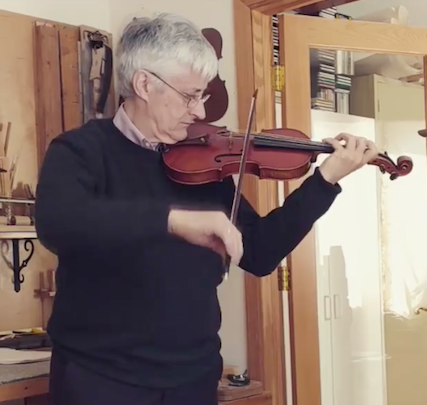"Every player of bowed instruments has similar questions about contemporary instruments; 'Can I play this instrument with people who have old instruments and not be embarrassed? Will I be able to hold my own in the orchestra, yet not stick out? Will its tone continue to please me, my colleagues, and my audience, or will its charms pale?'
Lots of my colleagues have shown up to perform with antiqued new instruments that look fine and create a good first impression, but once they start to be played everybody in the orchestra wonders, ”What’s going on with that sound?” The instrument will sound too dark and muddy or too bright and cold, or maybe too loud or too muffled, or even too harsh or not have any character.
Sure we players need an instrument that is powerful enough to be heard, but the thing we really need is an instrument with a lot of color, with a wide palette of tonal color, so if I need to play brighter, I can play brighter or, vice-versa, darker when I want to play darker. Unless an instrument has color, how can I shape the sound to express the feelings in the music? I did not become a musician to play a pretty fiddle but with a static, lifeless sound that makes me struggle to bring the music to life.
I recently played second violin in a quartet in Alice Tully Hall, with Jesse Levine, Fred Zlotkin, and John Dexter. The first violin was trying out a Strad, the violist had an Amati, and the cello was a Montagnana! In a situation like that I want to be secure and know that I can take my violin into these sort of circumstances--first rate players with fine antique instruments-- and feel confident I will get positive comments, that the tone of whatever instrument I am playing will blend with the tone of old master instruments, and also be consistent and reliable. Especially in an exposed setting like chamber music; to sit with a new $20,000 violin next to a player with a $2,000,000 antique, I want to know what am I going to be able to do, and that I will not sound like a fool! And my experience has taught me that a professional musician can make up for deficiencies in volume of tone, but never color of tone.
So for me COLOR is the crucial component in the sound of a new instrument. Can I take it anywhere and play successfully? Can I play-with one instrument- in a chamber group, as a member of an orchestral section, and as a soloist? Will it have the personality and subtlety to fulfill the intimacy of chamber music? Will it have enough strength to be a section player’s instrument without being stiff and static so that the concertmaster hears it stick out and never asks me back to play with them? Has it got the color to blend with the power to ring? AND does it have still more power so that I can play solo?
There are many nice old fiddles that are sweet, but have no power, and they limit my freedom. Likewise there are many modern instruments that have power, but they are harsh and loud, and the sound is not pleasing...you get sick of playing on it. It never seems to develop beyond being a Johnny-One-Note instrument.
I want a violin upon which I can play ALL periods of music in all settings. I want to be able to play Mozart, Wienieawski, and Bartok on my one instrument. You know, it seems every few years there is a new maker on the scene whose instruments enjoy a temporary vogue, but often their tone sticks out and has only one color, and people tired of them very soon and these fellows give modern makers a bad name. My Rufino is nothing like this and I am so happy to have found such a great instrument."
Note: Mr. Stuckenbruck purchased his Rufino in 1996 and it is still the only instrument he performs upon.


